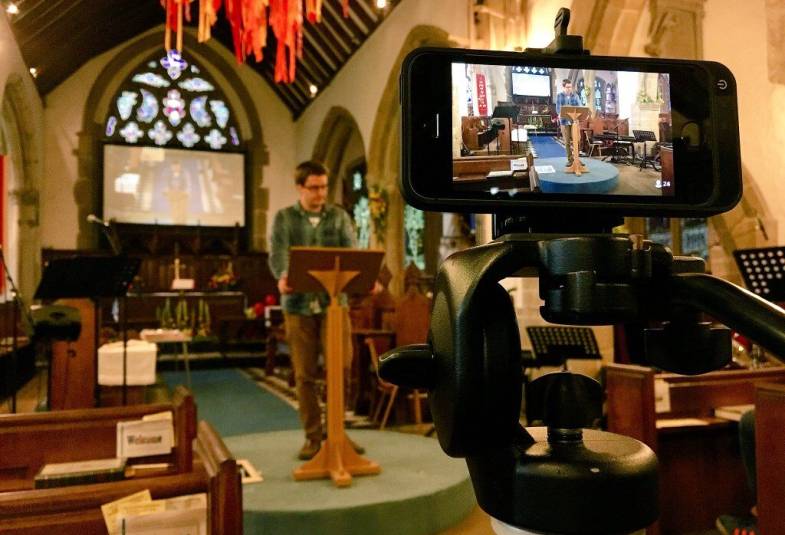17/08/2018
Videos on social media are now expected to have:
- Subtitles
- High sound and picture quality – only really achievable by using professional equipment
- Be short and fastmoving – with research suggesting videos on Facebook should be around 15 to 30 seconds!
For most churches, creating this kind of content regularly is out-of-reach.
However, there is a way that churches can create videos that perform well on social media with nothing more than a smart phone or tablet – and that’s by going live.
Live streaming has come a long way since Twitter bought and developed Periscope in 2015. Since then, behaviours and trends have changed, and short clips have been traded for the ability to stream longer clips, with more engagement from viewers.

Facebook Live, which launched to all Facebook users in 2016, has enabled pages to connect with their followers instantly, sharing about topics that matter to them and allowing viewers to have their say, ask questions and get involved.
Many churches are already using the Live feature on Facebook and now Instagram. Some great examples we’ve seen are members of a church’s leadership team discussing topics that might not be addressed during a Sunday service – like how, when and why you pray or tackling responses to big issues like why God allows suffering or what it means to be a Christian. Others have used it to fill Followers in about events and services that are going on at times like Christmas and Easter, giving people an idea of what the services might include and who’s invited. It’s also great to stream events that are taking place, especially if you know there are others who are interested who might not have been able to attend – we saw a church streaming the Remembrance Day parade in their town. Remember, the same rules apply around permissions, so think about who could be seen in the video.
A few years ago the Archbishop of Canterbury partnered with Facebook to do a series of discussions with his Chaplain about key areas of his faith and ministry. Take a look at those here. Could you do something similar?
The first time you go Live will be nerve-wracking, but this is a useful tool to master. 45 per cent of people watch more than an hour of Facebook or YouTube videos a week and more than 500 million (half a BILLION) people are watching video on Facebook every day (via Forbes). It’s particularly useful for reaching a younger audience, as the 25-34 age group watches the most online videos. Interestingly, men spend 40 per cent more time watching videos on the internet than women.
So, are you ready to give it a go?
Top tips for live streaming:
- Remember to tell your followers when you’ll be going live. Aim to give them 24 hours notice before a scheduled live stream, allowing them to make sure they watching. Build anticipation by making sure your posts shares a little but about what the stream will include.
- Make sure your signal is strong! Aim for Wifi, but if needs be you can use 4G, so long as the signal is strong enough. Do a test the day before on your own Facebook account – you can always delete this once you’ve finished.
- Think about your description. Write the post how you would any other update you’d share – give viewers an idea of what the stream is about, ask and question and encourage them to engage with you in the comments section. You’ll be able to see this interaction during the live stream, and can directly answer their questions while you’re live. Remember to mention the viewer by name when they ask a question and thank them for watching – this builds that community feel and makes the follower feel like a valued member of the community.
- Think about who and what can be seen – have all those who might appear been briefed, and what can be seen in the background? If you’re going Live to have a discussion, an attractive but simple background would work best. If you’re walking through your church during the coffee time after a service, have you told all those people who might like to talk to during the Live what you might ask them and how long you might talk to them? While you will want it to have a relaxed feel, Lives always work best when they’re planned.
- At the end of the live broadcast, ask viewers to subscribe to Live notifications so that they get an alert at the start of your next broadcast by following your page. There will be a Follow button on the video.
- While the trend for videos is shorter the better, when going Live it’s better to stay on for longer. You can stream for up to four hours on Facebook, but research shows around 20 minutes is the ideal time. Do you have enough planned to fill this time?
- Try to go Live regularly – followers will get to know what your Live videos are like and you will build a more loyal community of those watching. Could you try to go Live at least once a month?
Amaris Cole
Digital Content Manager
Keep up to date with all things digital and join our Labs Latest newsletter


